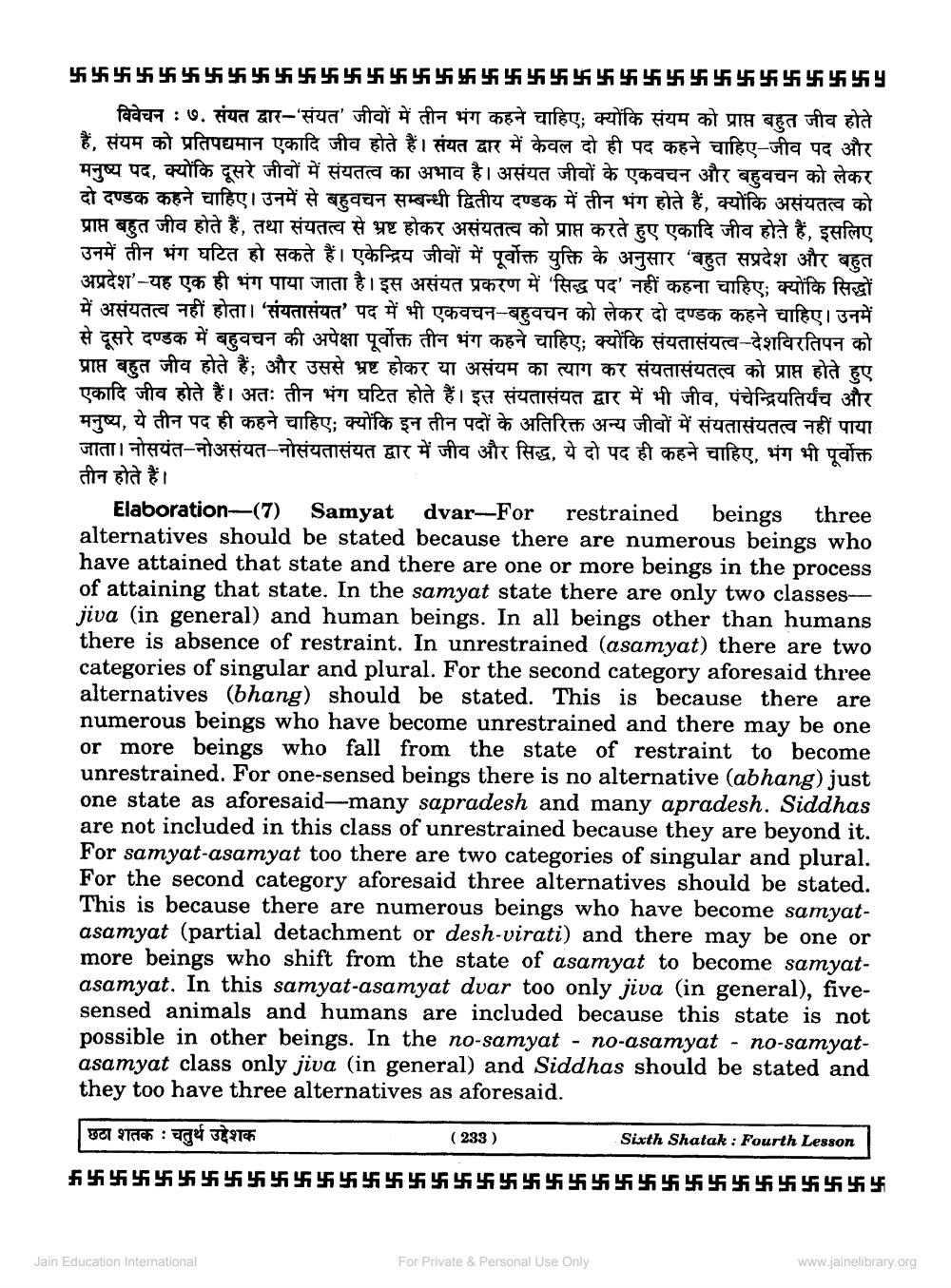________________
विवेचन : ७. संयत द्वार-'संयत' जीवों में तीन भंग कहने चाहिए, क्योंकि संयम को प्राप्त बहुत जीव होते
को प्रतिपद्यमान एकादि जीव होते हैं। संयत द्वार में केवल दो ही पद कहने चाहिए-जीव पद और मनुष्य पद, क्योंकि दूसरे जीवों में संयतत्व का अभाव है। असंयत जीवों के एकवचन और बहुवचन को लेकर दो दण्डक कहने चाहिए। उनमें से बहुवचन सम्बन्धी द्वितीय दण्डक में तीन भंग होते हैं, क्योंकि असंयतत्व को प्राप्त बहुत जीव होते हैं, तथा संयतत्व से भ्रष्ट होकर असंयतत्व को प्राप्त करते हुए एकादि जीव होते हैं, इसलिए उनमें तीन भंग घटित हो सकते हैं। एकेन्द्रिय जीवों में पूर्वोक्त युक्ति के अनुसार ‘बहुत सप्रदेश और बहुत अप्रदेश'-यह एक ही भंग पाया जाता है। इस असंयत प्रकरण में 'सिद्ध पद' नहीं कहना चाहिए; क्योंकि सिद्धों में असंयतत्व नहीं होता। 'संयतासंयत' पद में भी एकवचन-बहुवचन को लेकर दो दण्डक कहने चाहिए। उनमें से दूसरे दण्डक में बहुवचन की अपेक्षा पूर्वोक्त तीन भंग कहने चाहिए; क्योंकि संयतासंयत्व-देशविरतिपन को प्राप्त बहुत जीव होते हैं; और उससे भ्रष्ट होकर या असंयम का त्याग कर संयतासंयतत्व को प्राप्त होते हुए एकादि जीव होते हैं। अतः तीन भंग घटित होते हैं। इस संयतासंयत द्वार में भी जीव, पंचेन्द्रियतिर्यंच और मनुष्य, ये तीन पद ही कहने चाहिए; क्योंकि इन तीन पदों के अतिरिक्त अन्य जीवों में संयतासंयतत्व नहीं पाया जाता। नोसयंत-नोअसंयत-नोसंयतासंयत द्वार में जीव और सिद्ध, ये दो पद ही कहने चाहिए, भंग भी पूर्वोक्त तीन होते हैं।
Elaboration-(7) Samyat dvar-For restrained beings three alternatives should be stated because there are numerous beings who have attained that state and there are one or more beings in the process of attaining that state. In the samyat state there are only two classesjiva (in general) and human beings. In all beings other than humans there is absence of restraint. In unrestrained (asamyat) there are two categories of singular and plural. For the second category aforesaid three alternatives (bhang) should be stated. This is because there are numerous beings who have become unrestrained and there may be one or more beings who fall from the state of restraint to become unrestrained. For one-sensed beings there is no alternative (abhang) just one state as aforesaid-many sapradesh and many apradesh. Siddhas are not included in this class of unrestrained because they are beyond it. For samyat-asamyat too there are two categories of singular and plural. For the second category aforesaid three alternatives should be stated. This is because there are numerous beings who have become samyatasamyat (partial detachment or desh-virati) and there may be one or more beings who shift from the state of asamyat to become samyatasamyat. In this samyat-asamyat dvar too only jiva (in general), fivesensed animals and humans are included because this state is not possible in other beings. In the no-samyat - no-asamyat - no-samyatasamyat class only jiva (in general) and Siddhas should be stated and they too have three alternatives as aforesaid.
| छठा शतक : चतुर्थ उद्देशक
(233)
Sixth Shatak : Fourth Lesson
क)))))))))
))555555555555555
Jain Education International
For Private & Personal Use Only
www.jainelibrary.org




